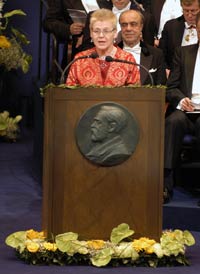Award ceremony speech
Presentation Speech by Professor Astrid Gräslund of the Royal Swedish Academy of Sciences, December 10, 2002.
Translation of the Swedish text.

Copyright © Nobel Media AB 2002
Photo: Hans Mehlin
Your Majesties, Your Royal Highnesses, Ladies and Gentlemen,
What would life be without proteins! Proteins are large molecules that do almost all the work in our cells. Every living organism, including a human being, has a large array of various kinds of proteins. Like diligent worker bees, they take care of what needs to be done. In principle, it works the same in this flower as in me or you.
To learn more about the diligent workers inside of cells, we want to know how they look, in order to understand what they do. This year’s Nobel Laureates in Chemistry have developed methods that enable us to weigh and create pictures of giant molecules like proteins in new ways that we could hardly believe were possible. I am convinced that biochemistry is now standing on the threshold of a new era – we are beginning to become acquainted with the complete genetic code of many organisms. Soon we will be able to survey all the thousands of protein varieties that work simultaneously in a given cell. It is in this new era that the discoveries of the 2002 Nobel Laureates are so important.
Mass spectrometry has been part of the chemist’s toolkit for identifying small molecules since the beginning of the 20th century. But for many years, being able to make accurate measurements of the molecular masses of large proteins was a dream for chemists. For this reason, it caused a minor revolution in the field when John Fenn and Koichi Tanaka, each in his own way, succeeded to making intact proteins fly through the mass spectrometer.
Fenn discovered that it was possible to spray a water solution of the protein, in the presence of an electrical field, in order to obtain hovering electrically charged drops. The water evaporates and the drops are scattered by their electrical charge, becoming smaller and smaller. Finally only pure protein molecules are left. Then their mass is determined by measuring the time it takes them to accelerate across a given distance – the principle being that the heavier the molecule is, the more slowly it moves.
Tanaka’s special method was to fire a laser pulse toward the sample. With the right wavelength in the laser, he could make the proteins be released from their surroundings without falling apart, so that they hovered freely as charged particles. Their mass could then also be determined by measuring their time of flight.
This was one half of the year’s Chemistry Prize – now I will move to the second half. This time it is not a matter of flying proteins, but swimming proteins. Using nuclear magnetic resonance, or NMR, a method that Kurt Wüthrich has further refined, it is now possible to determine the three-dimensional structure of protein molecules in a water solution. NMR is one of the chemist’s best methods for examining molecules, and it has been used extensively for small molecules since the mid-20th century. But large molecules like proteins involve special problems. One of the fine points of NMR is that it enables us to see individual signals, for example, from each hydrogen nucleus in a molecule. But because a protein can contain thousands of hydrogen nuclei, how do you know which signal belongs to which nucleus?
Wüthrich devised a way of systematically determining how each signal fits together with its special hydrogen nucleus. In the bargain, he was also able to determine a large number of pairwise distances between hydrogen nuclei. This enabled him to calculate a three-dimensional structure for the protein molecule. It is something like drawing a picture of a house if you know a large number of distances in the house. So thanks to Wüthrich’s discovery, we can now use NMR to examine and depict proteins in their natural environment, surrounded by water like in a cell.
So, what would life be without proteins? Since I view the world through the eyes of a biochemist, my answer is: nothing at all! Next question: How would life be as a biochemistry researcher without the tools that this year’s Nobel Laureates have given us? My answer to this question is: much more difficult, and also more dull! So I would like to conclude by saying to the 2002 Nobel Laureates in Chemistry: Thank you for your fantastic contributions, which help us to better understand the chemical miracles that constantly occur in our cells – what we call life.
Dr. Fenn, Mr. Tanaka and Dr. Wüthrich,
You have made pioneering contributions to the development of methods for identification and structure analyses of biological macromolecules. Your work to make mass spectrometry and NMR applicable for detailed studies of large molecules like proteins has given us new tools for investigations of the processes that constitute life. In recognition of your services to chemistry, the Royal Swedish Academy of Sciences has decided to confer upon you this year’s Nobel Prize in Chemistry.
On behalf of the Academy, I convey to you our warmest congratulations and I now ask you to receive the Prize from the hands of His Majesty the King.
Nobel Prizes and laureates
Six prizes were awarded for achievements that have conferred the greatest benefit to humankind. The 12 laureates' work and discoveries range from proteins' structures and machine learning to fighting for a world free of nuclear weapons.
See them all presented here.
